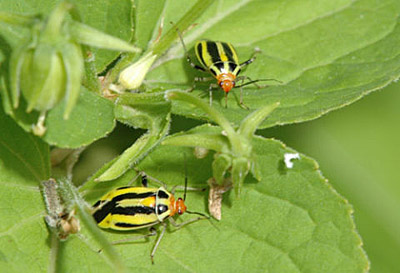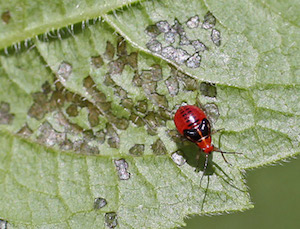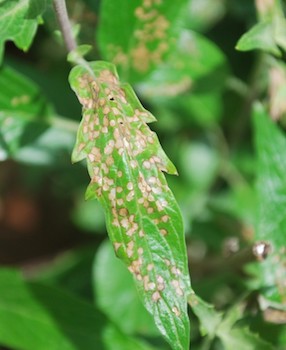Four Lines, One Bug
By Pat Dickey, Fairfax Master Gardener
 The four-lined plant bug (Poecilocapsus lineatus) causes injury to a wide variety of herbaceous perennials, shrubs, herbs and vegetables. None of the damage is life-threatening, but their piercing and sucking mouthparts can leave small holes in your new and tender plants.
The four-lined plant bug (Poecilocapsus lineatus) causes injury to a wide variety of herbaceous perennials, shrubs, herbs and vegetables. None of the damage is life-threatening, but their piercing and sucking mouthparts can leave small holes in your new and tender plants.
Adult bugs are yellowish-green with four black stripes along their backs. They are very small, only 3/16 inch long. When they hatch, they have black wing pads and dots on the abdomen. As nymphs, they are bright red to yellow in color. The nymphs’ heads are orange-brown. As the nymphs mature, they develop black wing pads that have a yellow stripe on each. The wing covers are not fully developed until they molt into adults.

Nymph stage
Feeding occurs for about six weeks in May and June. With their piercing mouthparts, the four-lined plant bug nymphs and adults feed on the tender growth of plants, then extract chlorophyll as they feed. While piercing the plants, they inject an enzyme, resulting in necrotic spots on the leaves. The centers of the spots eventually drop out, leaving small holes. Adults die after they mate and lay eggs for next year’s generation. There is one generation per year.

Typical damage
Inspect your plants early in the season. Nymphs are easier to control than adults, but both are very small, move quickly and will drop off of the foliage if they sense any disturbance. Try using a hard stream of water to dislodge the nymphs. Organic controls such as insecticidal soaps and horticultural oils may help to control them as well. Since they only feed for a short time, it is not cost-effective to use chemical controls. Most of the damage will be cosmetic.
References
Four-lined Plant Bugs are Active Now, Sandy Feather, Penn State Extension
Plant Bugs, Home and Garden Information Center, UMD Extension
Four-lined plant bugs, Jeffrey Hahn, University of Minnesota Extension